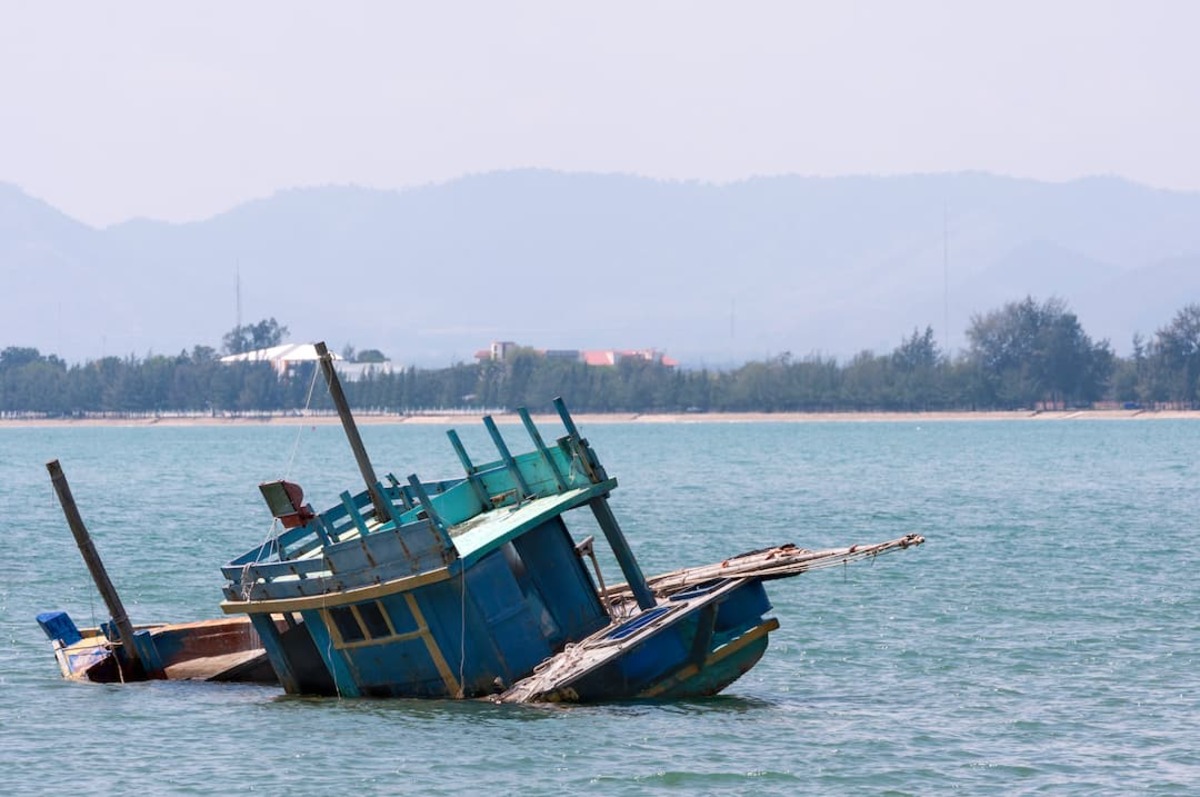Home>Health and Wellness>Surviving A Capsized Boat: Essential Tips To Stay Afloat!


Health and Wellness
Surviving A Capsized Boat: Essential Tips To Stay Afloat!
Modified: February 27, 2024
Learn essential tips for staying afloat after a boat capsizes. Ensure your health and wellness with expert advice on surviving this challenging situation.
(Many of the links in this article redirect to a specific reviewed product. Your purchase of these products through affiliate links helps to generate commission for Noodls.com, at no extra cost. Learn more)
Table of Contents
Introduction
Picture this: you're out on the open water, the sun shining overhead, the gentle sway of the boat lulling you into a state of relaxation. Suddenly, without warning, the boat capsizes, and you find yourself plunged into the cold, unforgiving depths. In this moment, the tranquil scene transforms into a fight for survival.
Surviving a capsized boat is a scenario that nobody wants to experience, but being prepared for such an event can make all the difference. This article will equip you with essential knowledge and strategies to navigate through the harrowing experience of a capsized boat. Whether you're a seasoned sailor or a novice adventurer, understanding the potential dangers, knowing the necessary equipment, and mastering survival techniques are crucial for staying afloat – both figuratively and literally.
In the following sections, we will delve into the perils of a capsized boat and the equipment needed for survival. We'll explore the importance of maintaining composure and focus in the midst of chaos, as well as the techniques for staying afloat and rescuing yourself and others. By the end of this article, you will have a comprehensive understanding of how to navigate the treacherous waters of a capsized boat and emerge with confidence and resilience.
So, fasten your life jacket and prepare to embark on a journey of knowledge and preparedness. Let's dive into the essential tips for surviving a capsized boat and emerge from the depths unscathed.
Understanding the Dangers of a Capsized Boat
When a boat capsizes, it's not just an inconvenience; it's a potentially life-threatening situation. Understanding the dangers associated with a capsized boat is crucial for preparing yourself mentally and physically to navigate through this perilous event.
The primary danger of a capsized boat is the immediate risk of drowning. As the boat overturns, occupants can be thrown into the water, often with little to no warning. The shock and disorientation that accompany this sudden immersion can lead to panic, making it difficult to assess the situation and take necessary actions.
In addition to the risk of drowning, a capsized boat exposes individuals to the elements. Depending on the location and weather conditions, exposure to cold water and adverse weather can lead to hypothermia, a potentially life-threatening condition. Even in relatively warm waters, prolonged exposure can lead to fatigue and diminished physical capabilities, making it challenging to stay afloat and await rescue.
Furthermore, a capsized boat can result in injuries, such as cuts, bruises, or broken bones, especially if individuals are tossed around during the capsizing. These injuries can further complicate the ability to stay afloat and navigate to safety.
Another significant danger of a capsized boat is the potential for separation from the vessel or other occupants. In the chaos of a capsizing, individuals may become disoriented and lose sight of the boat or fellow passengers. This isolation can intensify feelings of fear and helplessness, underscoring the importance of preparedness and swift, decisive action.
Understanding these dangers underscores the critical importance of preparedness, including having the necessary equipment and knowledge to mitigate risks and increase the likelihood of survival. In the following sections, we will explore essential equipment, survival techniques, and strategies for maintaining composure and focus in the face of adversity, all of which are essential for navigating the challenges posed by a capsized boat.
Essential Equipment for Surviving a Capsized Boat
When faced with the daunting scenario of a capsized boat, having the right equipment at your disposal can mean the difference between life and death. Preparedness is key, and the following essential equipment is vital for increasing your chances of survival:
-
Personal Flotation Devices (PFDs): PFDs are your lifeline in a capsized boat situation. These devices are designed to keep you buoyant and afloat, providing crucial support while awaiting rescue. Ensure that PFDs are readily accessible and properly fitted before setting out on any boating excursion.
-
Whistle or Signal Flares: Audible and visual signaling devices are indispensable for attracting attention and alerting nearby vessels or rescuers to your location. A whistle can be a simple yet effective tool for signaling distress, while signal flares are highly visible, especially in low-light conditions.
-
Waterproof Flashlight: In the event of a capsized boat at night or in low visibility conditions, a waterproof flashlight becomes an essential tool for illuminating your surroundings and signaling for help. Choose a reliable, waterproof flashlight that can withstand immersion and provide long-lasting illumination.
-
Knife or Multi-Tool: A sturdy knife or multi-tool can serve various purposes, from cutting entangled ropes or fishing lines to assisting in self-rescue efforts. Having a versatile cutting tool within reach can aid in freeing yourself from potential hazards in the water.
-
Emergency Whistle: An emergency whistle is a compact and powerful signaling device that can be heard over long distances, even in adverse weather conditions. It is an invaluable tool for attracting attention and communicating distress signals to potential rescuers.
-
Floating Rope or Throw Bag: A floating rope or throw bag can be used to extend a lifeline to individuals in the water or to establish a connection between multiple survivors. This can facilitate rescue efforts and provide a sense of security in turbulent waters.
-
Emergency Position Indicating Radio Beacon (EPIRB) or Personal Locator Beacon (PLB): These devices are designed to broadcast distress signals and your precise location to search and rescue authorities, greatly enhancing the chances of a swift and targeted rescue operation.
-
Dry Bag or Waterproof Container: Storing essential items, such as a first-aid kit, medications, and personal identification, in a waterproof container or dry bag ensures that critical supplies remain intact and accessible, even in the event of a capsized boat.
By equipping yourself with these essential items, you can significantly bolster your preparedness and resilience in the face of a capsized boat scenario. Remember that proactive preparation and the presence of necessary equipment are fundamental to surviving and ultimately overcoming the challenges posed by a capsized boat.
Staying Calm and Focused
Amidst the chaos and uncertainty of a capsized boat, maintaining a sense of calm and focus is paramount. The ability to keep a clear head and approach the situation with composure can significantly impact your chances of survival. Despite the overwhelming nature of the circumstances, there are several strategies that can help you stay grounded and focused on the task at hand.
First and foremost, it's essential to control your breathing. When faced with a sudden and distressing event like a boat capsizing, the body's natural response is often panic, leading to rapid, shallow breathing. By consciously slowing down your breath and taking deep, deliberate breaths, you can counteract the physiological effects of panic and regain a sense of control. Deep breathing not only oxygenates the body but also calms the mind, allowing you to think more clearly and rationally.
Next, focus on assessing your immediate surroundings and evaluating your condition. Take stock of your physical state and any injuries you may have sustained. Assess the stability of your flotation device and ensure that it is properly secured. By conducting this initial assessment, you can identify any pressing concerns and prioritize your next steps accordingly.
It's crucial to resist the urge to thrash about or make sudden, erratic movements. Instead, strive to remain as still as possible, conserving your energy and minimizing the risk of further disorientation or injury. By maintaining a steady posture, you can conserve energy and avoid exacerbating the situation.
Furthermore, mentally rehearse your plan of action. Visualize the steps you need to take to ensure your safety and the safety of others, if present. By mentally preparing yourself for potential challenges, you can approach the situation with greater confidence and decisiveness.
In the midst of a capsized boat scenario, it's natural to experience fear and uncertainty. Acknowledge these emotions, but endeavor to shift your focus towards practical and constructive actions. By channeling your energy into problem-solving and self-care, you can regain a sense of agency and control, mitigating the psychological impact of the situation.
Remember, staying calm and focused is not only beneficial for your own well-being but also for supporting and reassuring others who may be sharing the ordeal with you. Your ability to remain composed can serve as a source of stability and reassurance, fostering a collective mindset of resilience and determination.
In essence, staying calm and focused amidst the turmoil of a capsized boat is a skill that can be honed through mental preparedness, self-awareness, and deliberate action. By cultivating this mindset, you can navigate the challenges of a capsized boat with greater clarity, resilience, and ultimately, a heightened potential for survival.
Techniques for Staying Afloat
When confronted with the daunting reality of a capsized boat, mastering techniques for staying afloat is essential for increasing your chances of survival. The following strategies can empower you to navigate the turbulent waters with resilience and determination:
-
Positioning and Buoyancy: Upon finding yourself in the water after a boat capsizes, assume a position that maximizes your buoyancy. Tucking your knees to your chest and crossing your arms over your life jacket can help conserve body heat and maintain buoyancy. This posture also minimizes heat loss and reduces the strain on your muscles, allowing you to conserve energy.
-
Sculling and Treading Water: Utilize sculling motions with your hands and feet to stay afloat and maintain stability in the water. By gently moving your hands and feet in a scissor-like motion, you can propel yourself forward while conserving energy. Additionally, mastering the technique of treading water can help you stay afloat for extended periods, enabling you to await rescue or reach safety.
-
Breathing Control: Practice controlled breathing to conserve energy and maintain composure. By taking slow, deep breaths and exhaling steadily, you can regulate your oxygen intake and minimize the risk of hyperventilation. Controlled breathing also promotes a sense of calm, allowing you to focus on survival strategies and maintain a clear mindset.
-
Utilizing Flotation Devices: If available, make use of any floating debris or objects in the water to enhance your buoyancy. Clinging to a buoyant object, such as a cooler or life ring, can provide additional support and stability, reducing the physical exertion required to stay afloat. However, ensure that the object is secure and will not impede your movements or rescue efforts.
-
Conserving Energy: In a capsized boat scenario, conserving energy is paramount for prolonging your ability to stay afloat and await rescue. Minimize unnecessary movements and strive to maintain a steady, controlled posture to avoid expending valuable energy. By conserving energy, you can optimize your chances of survival and increase your endurance in the water.
By mastering these techniques for staying afloat, you can enhance your preparedness and resilience in the face of a capsized boat scenario. These strategies not only increase your likelihood of survival but also empower you to navigate the challenges of a capsized boat with confidence and determination. Remember, staying afloat is not only a physical endeavor but also a testament to your mental fortitude and resourcefulness in the face of adversity.
Rescuing Yourself and Others
In the event of a capsized boat, the ability to initiate self-rescue and assist others in need is critical for navigating the challenges of the situation. By mastering effective rescue techniques and leveraging available resources, individuals can significantly enhance their chances of survival and contribute to the safety of fellow occupants.
Assessing the Situation
Upon finding yourself in a capsized boat scenario, it is essential to swiftly assess the condition of all individuals involved. Determine the number of people in the water and their proximity to the capsized vessel. Identify any injuries or signs of distress that require immediate attention. Assessing the situation allows you to prioritize rescue efforts and allocate resources effectively.
Establishing Communication
Clear and concise communication is vital in coordinating rescue efforts. If there are other survivors in the water, establish verbal or visual communication to assess their condition and provide reassurance. Determine if anyone requires immediate assistance or has specific needs that must be addressed. Effective communication fosters a sense of unity and collaboration, essential for executing successful rescue maneuvers.
Self-Rescue Techniques
Initiating self-rescue measures is paramount for ensuring personal safety and stability. If equipped with a floating object or debris, use it to maintain buoyancy and conserve energy. Orient yourself towards the nearest safe location, such as a shore or another vessel, and steadily propel yourself in that direction. Implementing controlled breathing and efficient swimming techniques can aid in self-rescue, allowing you to reach safety or provide assistance to others.
Read more: How To Draw A Boat
Assisting Others
In a capsized boat scenario, lending assistance to fellow survivors is an act of solidarity and compassion. If individuals are struggling to stay afloat or exhibiting signs of distress, approach them calmly and offer support. Utilize available flotation devices or ropes to extend aid to those in need. Encourage and guide others to maintain a steady posture and conserve energy while awaiting rescue. Prioritize the safety and well-being of all individuals, fostering a collective spirit of resilience and mutual support.
Signal for Rescue
Employ signaling devices, such as whistles or signal flares, to attract the attention of nearby vessels or potential rescuers. Emit audible distress signals and utilize visual cues to indicate your location and the presence of other survivors. Coordinate signaling efforts with fellow occupants to maximize visibility and convey a unified call for assistance. By effectively signaling for rescue, you enhance the likelihood of prompt and targeted assistance.
Collaborative Rescue Efforts
Collaboration and teamwork are instrumental in executing successful rescue operations. Coordinate with other survivors to establish a collective plan for self-rescue and mutual assistance. Pool resources and devise strategies to maximize the safety and well-being of all individuals involved. By fostering a sense of unity and collaboration, you can optimize the effectiveness of rescue efforts and navigate the challenges of a capsized boat with resilience and determination.
In essence, the ability to rescue oneself and assist others in a capsized boat scenario hinges on swift assessment, effective communication, and proactive measures. By mastering these essential rescue techniques, individuals can bolster their preparedness and resilience, ultimately increasing their chances of survival and fostering a spirit of solidarity amidst adversity.
Conclusion
Surviving a capsized boat demands a combination of preparedness, resilience, and resourcefulness. The harrowing experience of a boat capsizing presents individuals with a myriad of challenges, from the immediate risk of drowning to the potential for isolation and exposure to the elements. However, armed with essential knowledge and equipped with the right tools, individuals can navigate through this perilous event with confidence and determination.
Understanding the dangers of a capsized boat underscores the critical importance of preparedness, emphasizing the need for essential equipment and the mastery of survival techniques. From the initial shock of immersion to the potential for separation from the vessel or fellow occupants, comprehending the risks inherent in a capsized boat scenario empowers individuals to anticipate challenges and respond effectively.
The significance of essential equipment cannot be overstated, as personal flotation devices, signaling devices, and versatile tools serve as lifelines in the face of adversity. These items not only enhance buoyancy and visibility but also facilitate self-rescue efforts and the assistance of others. By prioritizing the presence and accessibility of crucial equipment, individuals bolster their readiness and fortify their ability to confront the unexpected.
Staying calm and focused emerges as a cornerstone of survival amidst the turmoil of a capsized boat. The ability to regulate breathing, assess surroundings, and channel emotions into constructive actions embodies the resilience necessary to navigate through the chaos. By maintaining composure, individuals not only safeguard their own well-being but also provide a source of stability and reassurance for fellow survivors.
Mastering techniques for staying afloat is pivotal for prolonging endurance and optimizing the chances of survival. From positioning and buoyancy to controlled breathing and the utilization of flotation devices, these strategies empower individuals to navigate the waters with resilience and determination. Staying afloat is not merely a physical feat but a testament to mental fortitude and adaptability in the face of adversity.
The capacity to initiate self-rescue and assist others in a capsized boat scenario epitomizes the spirit of solidarity and compassion. By swiftly assessing the situation, establishing communication, and executing collaborative rescue efforts, individuals amplify their chances of survival and foster a collective mindset of resilience and mutual support.
In essence, the journey of surviving a capsized boat is a testament to the human spirit's capacity for resilience, adaptability, and compassion. By embracing preparedness, mastering essential skills, and fostering a collective spirit of unity, individuals can navigate through the challenges of a capsized boat and emerge with a profound sense of strength and solidarity.













